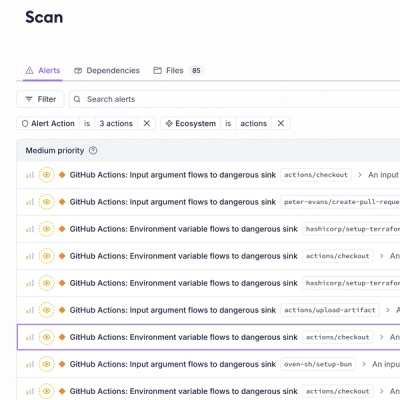
Product
Introducing Socket Firewall Enterprise: Flexible, Configurable Protection for Modern Package Ecosystems
Socket Firewall Enterprise is now available with flexible deployment, configurable policies, and expanded language support.
buffer-backed-object
Advanced tools
**`BufferBackedObject` creates objects that are backed by an `ArrayBuffer`**. It takes a schema definition and de/serializes data on-demand using [`DataView`][dataview] under the hood. The goal is to make [`ArrayBuffer`][arraybuffer]s more convenient to u
BufferBackedObjectBufferBackedObject creates objects that are backed by an ArrayBuffer. It takes a schema definition and de/serializes data on-demand using DataView under the hood. The goal is to make ArrayBuffers more convenient to use.
npm i -S buffer-backed-object
When using Web Workers, the performance of postMessage() (or the structured clone algorithm to be exact) is often a concern. While postMessage() is a lot faster than most people give it credit for, it can still occasionally be a bottle-neck, especially with bigger payloads. ArrayBuffer and their views are incredibly quick to clone (or can even be transferred), but getting data in and out of ArrayBuffers can be cumbersome. BufferBackedObject makes this easy by giving you a (seemingly) normal JavaScript object that reads and write values from the ArrayBuffer on demand. This means that the serialization & deserialization costs are deferred to the point of access rather than paid upfront, as it is the case with postMessage().
WebGL Buffers can store multiple attributes per vertex using vertexAttribPointer(). These attributes can be a 3D position, but also other additional data like a normal vector, a color or a texture ID. The underlying buffer contains all the attributes for all the vertices in an interleaved format, which can make manipulating that data quite hard. With ArrayOfBufferBackedObjects you can manipulate each vertex individually. Additionally, ArrayOfBufferBackedObjects is populated lazily (see more below), allowing you to handle big arrays of vertices more efficiently.
Similary, you can define structs in WGLS and read from/write to GPU memory buffers. With BufferBackedObject or ArrayOfBufferBackedObjects, you can manipulate those structs from JavaScript more easily and efficiently.
import * as BBO from "buffer-backed-object";
const buffer = new ArrayBuffer(100);
const view = BBO.BufferBackedObject(buffer, {
id: BBO.BufferBackedObject.Uint16({ endianness: "big" }),
position: BBO.NestedBufferBackedObject({
x: BBO.Float32(),
y: BBO.Float32(),
z: BBO.Float32(),
}),
normal: BBO.NestedBufferBackedObject({
x: BBO.Float32(),
y: BBO.Float32(),
z: BBO.Float32(),
}),
textureId: BBO.Uint8(),
});
view.id = 3;
console.log(new Uint8Array(buffer));
// logs: Uint8Array(100) [3, 0, ...]
console.log(JSON.stringify(view));
// logs: {"id": 3, "position": {"x": 0, ...}, ...}
ArrayOfBufferBackedObjects interprets the given ArrayBuffer as an array of objects with the given schema:
import * as BBO from "buffer-backed-object";
const buffer = new ArrayBuffer(100);
const view = BBO.ArrayOfBufferBackedObjects(buffer, {
id: BBO.Uint16({ endianness: "big" }),
position: BBO.NestedBufferBackedObject({
x: BBO.Float32(),
y: BBO.Float32(),
z: BBO.Float32(),
}),
normal: BBO.NestedBufferBackedObject({
x: BBO.Float32(),
y: BBO.Float32(),
z: BBO.Float32(),
}),
textureId: BBO.Uint8(),
});
// The struct takes up a total of 27 bytes, so
// 3 structs can fit into a 100 byte `ArrayBuffer`.
console.log(view.length);
// logs: 3
view[0].id = 1000;
view[1].id = 1001;
view[2].id = 1002;
console.log(new Uint8Array(buffer));
// logs: Uint8Array(100) [232, 3, ...]
console.log(JSON.stringify(view));
// logs: [{"id": 1000, ...}, {"id": 1001}, ...]
The module has the following exports:
function BufferBackedObject(buffer, descriptors, {byteOffset = 0})The key/value pairs in the descriptors object must be declared in the same order as they are laid out in the buffer. The returned object has getters and setters for each of descriptors properties and de/serializes them buffer, starting at the given byteOffset.
function ArrayOfBufferBackedObjects(buffer, descriptors, {byteOffset = 0, length = 0})Like BufferBackedObject, but returns an array of BufferBackedObjects. If length is 0, as much of the buffer is used as possible. The array is populated lazily under the hood for performance purposes. That is, the individual BufferBackedObjects will only be created when their index is accessed.
function structSize(descriptors)Returns the number of bytes required to store a value with the schema outlined by descriptors.
The following descriptor types are available as individually exported functions
function reserved(numBytes): A number of unused bytes. This field will now show up in the object.function Int8(): An 8-bit signed integerfunction Uint8(): An 8-bit unsigned integerfunction Int16({align = 2, endianness = 'little'}): An 16-bit signed integerfunction Uint16({align = 2, endianness = 'little'}): An 16-bit unsigned integerfunction Int32({align = 4, endianness = 'little'}): An 32-bit signed integerfunction Uint32({align = 4, endianness = 'little'}): An 32-bit unsigned integerfunction BigInt64({align = 8, endianness = 'little'}): An 64-bit signed BigIntfunction BigUint64({align = 8, endianness = 'little'}): An 64-bit unsigned BigIntfunction Float32({align = 4, endianness = 'little'}): An 32-bit IEEE754 floatfunction Float64({align = 8, endianness = 'little'}): An 64-bit IEEE754 float (“double”)function UTF8String(maxBytes): A UTF-8 encoded string with the given maximum number of bytes. Trailing NULL bytes will be trimmed after decoding.function NestedBufferBackedObject(descriptors): A nested BufferBackedObject with the given descriptorsfunction NestedArrayOfBufferBackedObjects(numItems, descriptors): A nested ArrayOfBufferBackedObjects of length numItems with the given descriptorsAll the descriptor functions return an object with the following structure:
{
align?: 1, // Required aligment
size: 4, // Size required by the type
get(dataView, byteOffset) {
// Decode the value at byteOffset using
// `dataView` or `dataView.buffer` and
// return it.
},
set(dataView, byteOffset, value) {
// Store `value` at `byteOffset` using
// `dataView` or `dataView.buffer`.
}
}
License Apache-2.0
FAQs
**`BufferBackedObject` creates objects that are backed by an `ArrayBuffer`**. It takes a schema definition and de/serializes data on-demand using [`DataView`][dataview] under the hood. The goal is to make [`ArrayBuffer`][arraybuffer]s more convenient to u
We found that buffer-backed-object demonstrated a not healthy version release cadence and project activity because the last version was released a year ago. It has 2 open source maintainers collaborating on the project.
Did you know?

Socket for GitHub automatically highlights issues in each pull request and monitors the health of all your open source dependencies. Discover the contents of your packages and block harmful activity before you install or update your dependencies.

Product
Socket Firewall Enterprise is now available with flexible deployment, configurable policies, and expanded language support.

Security News
Open source dashboard CNAPulse tracks CVE Numbering Authorities’ publishing activity, highlighting trends and transparency across the CVE ecosystem.

Product
Detect malware, unsafe data flows, and license issues in GitHub Actions with Socket’s new workflow scanning support.